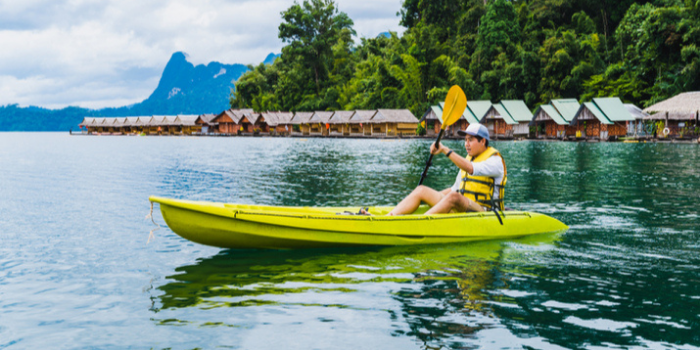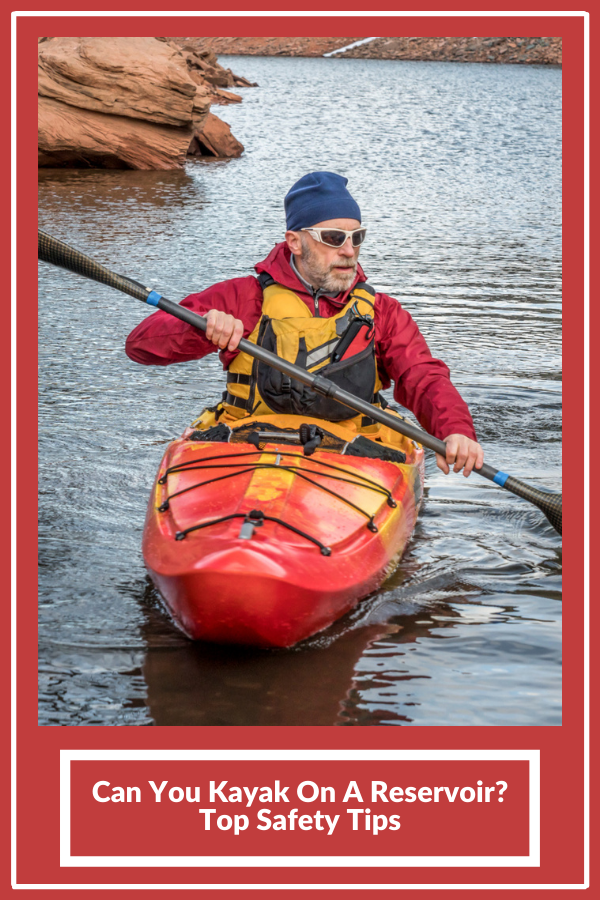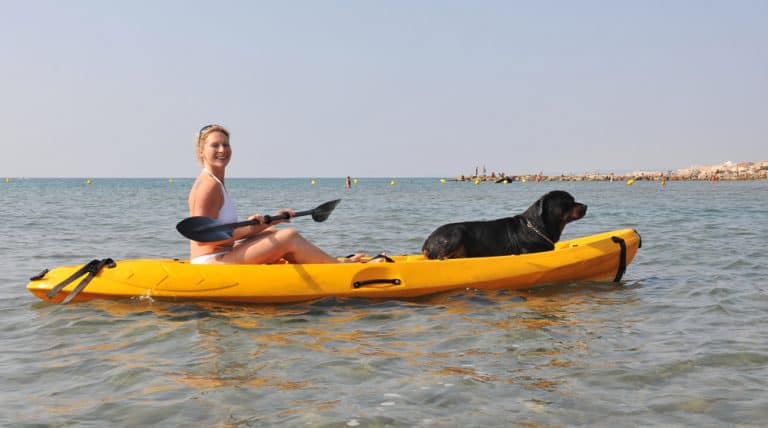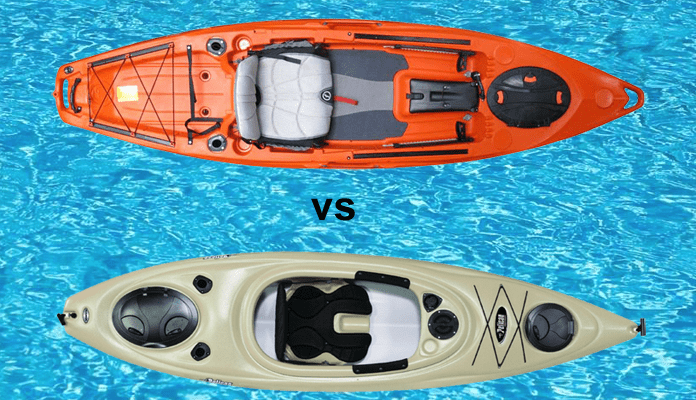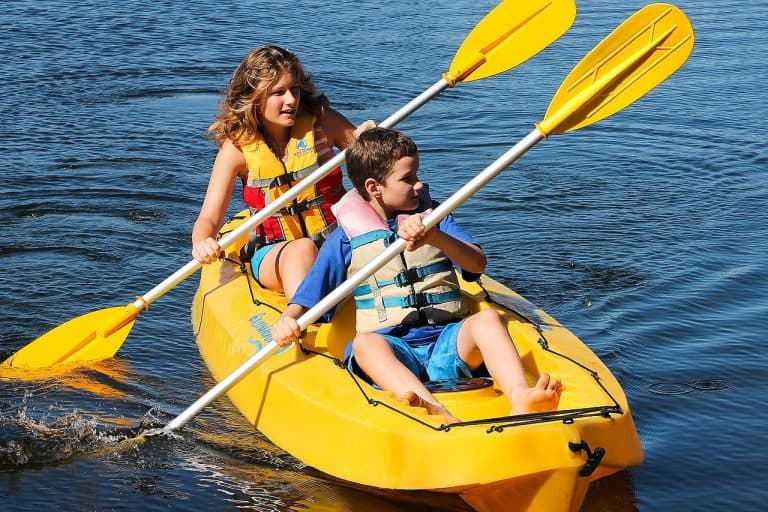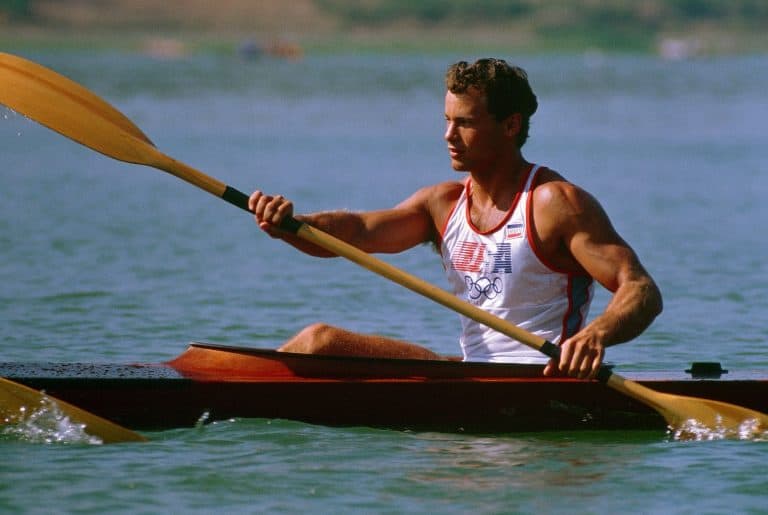You have probably heard of people kayaking on lakes, streams, rivers, creeks, protected saltwater bays, and even the open ocean. The question of can you kayak on a reservoir remains.
These bodies of water differ from all the rest for several important reasons and, as such, this is a valid question. This is especially true if you are new to kayaking and you are trying to find the safest place in your area to hone your skills.
Fortunately, these bodies of water can be a safe place to paddle and they are actually the preferred destination for a certain type of paddler. We are going to dive into who that would be and how you can make your reservoir paddles as safe as possible in this guide.
Photo by Sriya Pixels via Shutterstock
What Is The Definition of A Reservoir?
Photo by Kletr via Shutterstock
According to Study.com, “a reservoir is a man-made lake or large freshwater body of water.” Many people will use the terms ”˜lake’ and ”˜reservoir’ interchangeably, but they are, in fact, different.
Most reservoirs are formed by either diverting or damming a source of flowing water. There are actually three different types of reservoirs that are respectively referred to as valley-dammed, bank-side, and service reservoirs.
Valley-dammed reservoirs are created in valleys between mountains or ridges where there is already an existing lake or body of water of some kind. One of the most famous examples of a valley-dammed reservoir is Lake Mead, which was created by the formation of the Hoover Dam.
We create bank-side reservoirs by diverting a flowing body of water into an existing holding area. One of the more famous examples of this type of reservoir is the River Thames in London.
The last type of reservoir is a service reservoir and it is completely man-made. It is created by digging a large cistern or holding area above or below ground that water can be stored or diverted into for future use.
Can You Kayak On A Reservoir?
Photo by Creative Family via Shutterstock
You can certainly kayak on a reservoir! You will simply need to choose a safe launching and landing location, know the regular wind patterns, and be conscious of any areas that are designated as “off-limits” to non-motorized watercraft.
Most reservoirs do offer great paddling because they have these longer “fingers” that can be protected from the wind. These fingers also provide opportunities to explore more remote stretches of coastline that can be better for wildlife viewing and bird watching.
Reservoirs can also be attractive to more experienced paddlers that are interested in planning a multi-day paddling trip with overnight camping. If you have one of the best touring kayaks and want to plan an overnight trip, check to see if any of the reservoirs in your area have shoreline campsites that can only be accessed by boat or paddle craft.
Reservoirs do, however, offer some dangers and risks that other types of waterways do not. So we will cover those briefly in the following section.
What Are The Risks of Kayaking On A Reservoir?
All forms of kayaking come with some level of risk and that is true regardless of the type of kayak you are paddling and where you take it. We will use this time to focus on some of the risks of reservoir kayaking.
Motorized Vessels
Photo by Richard Pross via Shutterstock
Reservoirs are often really popular locations for many types of on-water recreation. Boating and jet skiing enthusiasts will often call reservoirs home for the duration of their favorite season.
This means that kayakers on reservoirs can sometimes contend with more motorized vessel traffic than they would have to on other bodies of water. The risks of this extra traffic include larger waves and the possibility of being struck by a boater or jet skier that is not aware of your presence.
Some kayakers do not like this simply because they are stuck paddling around a lot of other people when they were really seeking solitude and quiet. Others simply fear for their safety when trying to paddle amongst too many motorized vessels.
Fortunately, there are ways to mitigate these risks, but you should still be aware of them.
Fluctuating Water Levels
Photo by Christian Schwier via Shutterstock
As we mentioned earlier, reservoirs are created by the formation of a dam that essentially blocks the waters of a stream or river from flowing downstream at their natural pace. Once constructed, that dam is then responsible for controlling the downstream flow of water that it releases.
In turn, the amount of water that is being let out of the dam will impact the surface level of the reservoir. There are many different agencies that manage dam operations around the country, but the Army Corps of Engineers is by far the largest.
On the ground, this means that accessibility to a good place to launch your kayak onto a reservoir can change with the seasons. In extreme cases, it may even change overnight if the dam operator needs to let a lot of water out.
We have shown up at our favorite reservoir launch site only to find the water down about 10 feet and our launch virtually inaccessible. There are, of course, other ways that fluctuating water levels can impact your ability to kayak on a reservoir as well.
Water levels can rise overnight and threaten to carry away your kayak on an overnight camping trip. These changes can also dramatically impact water temperatures and, in turn, increase (or decrease) the risk of hypothermia when paddling.
Typically, however, these changes are so negligible that most paddlers will hardly notice major shifts over the course of a season. That said, they are still worth being aware of if you like to paddle on a reservoir.
Water Quality
Photo by Igor Samoilik via Shutterstock
You have to keep in mind that many of these reservoirs are in locations where a “lake” is not natural. Plus, the unnatural holding of vast amounts of water for long periods of time can cause certain bacteria to grow and multiply.
This is why some dams will occasionally release what is known as a “toxic load” downstream. These releases of bacteria-laden water can threaten fisheries, agriculture, and wetland ecosystems as they run downstream.
For kayakers in reservoirs, it can also mean muckier waters and less visibility. At some reservoirs, you may even see signs along the shoreline that advise against swimming as things heat up later in the summer.
While your style of kayaking might keep you dry and out of the water for the duration of your paddle, that may not be the case for all. If, for example, you are heading to your local reservoir to practice your put across rolls, you may want to check on the water quality first.
Invasive Species
Photo by Jeff Caughey via Shutterstock
Sadly, there are a number of aquatic invasive species that threaten the health of lake and reservoir ecosystems all over the country. Some of the more famous species are the Zebra mussels and Eurasian Watermilfoil.
These species pose numerous risks to plant and animal life in reservoirs and they are often transmitted between bodies of water by boats and non-motorized watercraft (like kayaks!).
While these species may not present a direct threat to your health, you should be careful to completely clean and dry your kayak when transferring it between bodies of water in order to limit the spread of aquatic invasive species.
Top Safety Tips For Reservoir Kayaking
Now that we have discussed the main risks of kayaking on a reservoir, it is time to discuss the ways that you can mitigate those risks. Some of them are related to your personal safety and others are more relevant to the safety of your reservoir as a whole.
Equip Your Kayak With the Right Safety Equipment
Photo by Backbone Campaign via Flickr
While safe kayaking always begins with getting (and wearing) one of the best life vests for kayaking, there are some other things you can add to your vessel to enjoy a safer experience on your local reservoir.
If you ever paddle at dawn or dusk, you should have a kayak light that signals your presence to other boaters. If your reservoir is particularly crowded, you may even consider getting a kayak flag to attach to the back of your vessel to increase your visibility.
On that visibility note, keep in mind that you also have a choice of the color of your kayak, your PFD, and your clothing when you are on the water. Brighter colors are always going to be better to increase your visibility to other boaters.
In addition to taking measures to increase your visibility, you should also have the right kayaking emergency equipment on board at all times. This will help you handle an unexpected emergency if it arises (and that is true no matter where you are paddling).
Check The Dam Release Schedule
Photo by Garudachedu Vishnu via Shutterstock
If you are kayaking on a valley-dammed reservoir, it can be helpful to know the release schedule to help you avoid being overly surprised by fluctuating water levels. If you know water levels are going to drop overnight, that can also impact your choice of launching locations.
Nobody likes trying to launch on a shoreline that is exceptionally muddy because the lake dropped 4-5 feet overnight. We have seen plenty of kayakers lose nice sandals and other valuables when trying to launch at a particularly muddy spot.
In addition to checking the dam release schedule for your local reservoir, you can also monitor the water level on the lake’s surface. When water levels drop, certain hazards can become exposed or become dangerously hidden just below the surface of the water.
While it is impossible to avoid all unforeseeable obstacles in this scenario, knowing water levels and release times will help you prepare for more successful reservoir paddling.
Be Aware Of Algal Blooms and Other Water Quality Metrics
Photo by Avatar_023 via Shutterstock
The water quality in many reservoirs is actively being studied and tested in order to provide safe water for recreation, fisheries, agriculture, and a variety of other purposes. The Army Corps of Engineers at each reservoir will be monitoring that site, but it may also be monitored by a state or municipal agency.
Checking the data that is available to the public from as many agencies as possible is the best way to get a better picture of the water quality in your reservoir. Monitoring that data over time will also give you a better idea of the safest times to paddle or swim in your reservoir.
Again, paddling in a reservoir with questionable water quality isn’t out of the question. If you have experience and the weather conditions create a minimal risk of capsizing, you will most likely be safe and dry for the duration of your paddle.
Just be aware that prolonged submersions or exposure may not be recommended at certain times of the year on your local reservoir. Aside from avoiding the reservoir altogether at these times, there is unfortunately not much more you can do to avoid the risk of poor water quality.
Clean and Dry Your Kayak Between Uses
Photo by Heather Wharram via Shutterstock
This safety tip is especially important if you know that there are aquatic invasive species in your reservoir. It is the best method to avoid transferring those species to other (potentially healthier) bodies of water in your area.
Of course, there is less urgency to heed this safety tip if you always paddle in the same reservoir and you never take your kayak anywhere else. For the rest of you, it is good to wipe your entire kayak down after you pull it out of the water.
This also means opening up all of your bulkheads and storage compartments and wiping them out as well. Take out all of your gear and allow anything that has gotten wet to dry completely before packing it away.
If you have to get home quickly at the end of your paddle, there is no harm in packing things away and then laying them out to dry when you get home. Just know that invasive species are more likely to survive in wet environments.
Be Aware of The Weather
Photo by Sytilin Pavel via Shutterstock
You will honestly find reservoirs in nearly every corner of the country. So this suggestion is more relevant to general kayaking safety than it is particular to kayaking on a reservoir.
Even if it is a completely sunny day with relatively minimal wind when you start your kayak, conditions can change rapidly. Reservoirs that are situated in mountainous regions are particularly known for having large thunderstorms develop over them later in the afternoon.
On the flip side, reservoirs in hotter and drier parts of the country may have little to no tree life along their shores. This means a relative lack of shade if you need to get off the lake and cool down for a few minutes.
Both of these extremes require different levels of preparation, so it is important for you to know the weather and monitor it frequently. It is always better to err on the side of caution than to get stuck in the middle of a reservoir with a massive thundercloud booming overhead.
Pack Layers
Photo by Peakstock via Shutterstock
You may think that this is a silly suggestion given that many reservoirs offer calm paddling conditions compared to many other bodies of water. An experienced kayaker knows, however, that it is always better to be overprepared than to be underprepared.
You should always have a few extra layers stuffed in a dry bag somewhere on your kayak. Depending on your trip, this could be as minimal as a rain jacket or as inclusive as a full change of clothes.
The extra weight of these layers is going to prove negligible in terms of the energy you exert to paddle your kayak. This is especially true when compared to the risks and just general discomfort that can come with paddling in wet layers when you could have had a change of clothes at your disposal.
Conclusion
Photo by Khairil Azhar Junos via Shutterstock
The truth of the matter is that reservoirs are great places for owners of one of the best kayaks for beginners to hone their skills. They are more forgiving and provide easier paddling conditions than many other types of waterways.
Even though they are man-made, the shorelines surrounding reservoirs often boast a healthy ecosystem of fishing birds and large mammals. So these waterways can also be great places to view wildlife from your kayak.
Once you have the right kayak at your disposal, there is no reason you can’t kayak on the closest reservoir to your house. Just make sure you heed our top safety tips to make your paddling experience safe and enjoyable for all!

